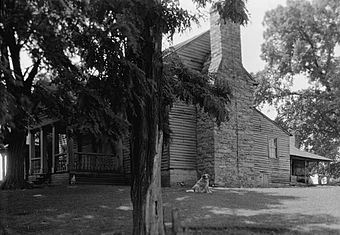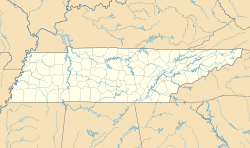Tipton-Haynes State Historic Site facts for kids
Quick facts for kids |
|
|
Tipton-Haynes House
|
|

Tipton-Haynes House in 1936
|
|
| Location | 2620 South Roan Street, Johnson City, Tennessee |
|---|---|
| Built | 1784 |
| Architect | John Tipton |
| NRHP reference No. | 70000620 |
| Added to NRHP | February 26, 1970 |
The Tipton-Haynes State Historic Site, also known as the Tipton-Haynes House, is a special historical place in Johnson City, Tennessee. It's located at 2620 South Roan Street. This site includes a house built way back in 1784 by Colonel John Tipton.
Besides the main house, there are 10 other old buildings on the property. These include a smokehouse, a pigsty, a loom house, and a springhouse. You can also see a log barn and a corncrib. There's even a home that belonged to George Haynes, who was a slave of the Haynes family.
Contents
A Look at the Tipton-Haynes Site
Who Was John Tipton?
Colonel John Tipton was an important person in early Tennessee history. He was known for opposing the State of Franklin. This was an attempt by people living in the Tennessee Valley to create their own state in the mid-1780s. It didn't work out in the end.
The Franklin Conflict
In February 1788, a disagreement happened at the Tipton farm. This event is sometimes called the "Battle of Franklin." A group led by John Sevier, who wanted to be the governor of the new State of Franklin, surrounded Tipton's farm. Sevier demanded that Tipton return some slaves. Tipton had taken them from Sevier based on a court order from North Carolina.
Tipton refused to give them back. Gunfire was exchanged, and then there was a two-day standoff. Eventually, forces from Sullivan County arrived and scattered Sevier's group. After this event, the idea of the State of Franklin mostly faded away.
How the Farm Changed Hands
From Tipton to Haynes
After John Tipton passed away in 1813, his son, John Tipton, Jr., took over the farm. John Tipton, Jr. died in 1831. His family then sold the property in 1837 to David Haynes, who bought and sold land in the area.
In 1839, David Haynes gave the farm to his son, Landon Carter Haynes, as a wedding gift. Landon Carter Haynes made the house bigger and added weatherboarding to its outside.
A Senator's Story
Landon Carter Haynes became a senator for the Confederacy during the Civil War. Because of the war, he had to leave the region in 1865. He sold the farm to his brother-in-law, Lawson Gifford, who was a publisher from Jonesborough.
In 1945, Lawson Gifford's grandson, David Simmerly, sold the farm to the Tennessee Historical Commission. However, David Simmerly continued to live there until he passed away.
The Site Today
The Tipton-Haynes State Historic Site is one of 18 such sites in Tennessee. It is managed by the Tipton-Haynes Association. They work together with the Tennessee Historical Commission to keep the site open and educational. The site was officially added to the National Register of Historic Places in 1970, recognizing its importance in history.



